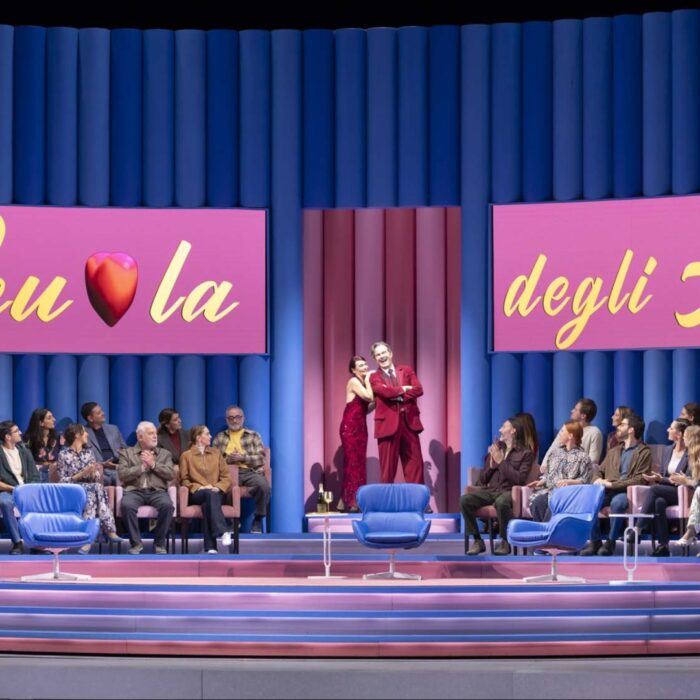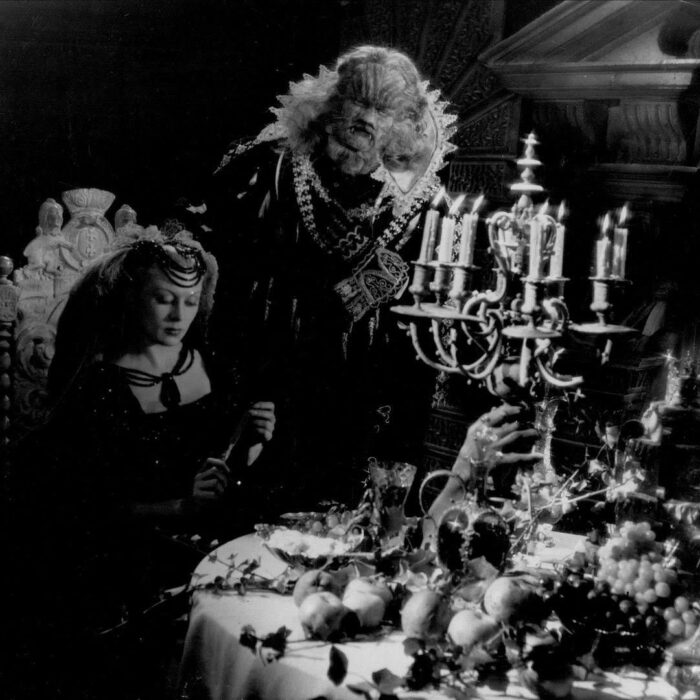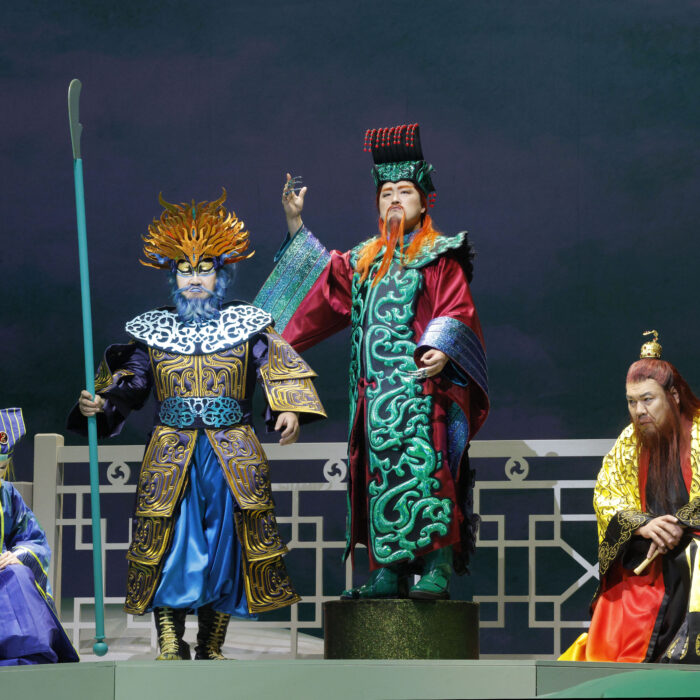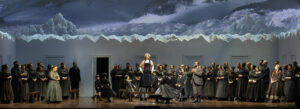
Metropolitan Opera 2025-26 Review: La Sonnambula
Xabier Anduaga Shines In a Disappointing Bel Canto Evening
By Francisco Salazar(Credit: Marty Sohl / Met Opera)
The last time the Metropolitan Opera presented a new production of Bellini’s “La Sonnambula” was in 2009, when Mary Zimmerman set the opera in a modern rehearsal room.
It was a divisive production that ultimately made no sense and deviated completely from the original story. Now in 2025, the Metropolitan Opera is seeking to correct the regietheater concept production with a more traditional one by tenor Rolando Villazón.
The result was an equally perplexing production with uneven singing that disappointed in every way.
Static & Manic
As a renowned tenor, Villazón sang in some of the most memorable productions of the past two decades. Then, he started directing over a decade ago to great acclaim and for his Met directing debut, he decided to bring his recent “Sonnambula” production, which was first seen at the Théâtre des Champs-Élysées, the Semperoper Dresden, and the Opéra de Nice.
The production is divided into a two-tier set that showcases a snow-capped background towering over a town square. The snow-capped background is supposed to express the free world, while the town square, which is a bunch of walls with doors, is supposed to express the rigidity and the claustrophobia of being trapped in that latter world. The chorus and the actors express the conservative townspeople who are stuck in their ways, while Amina is an outsider who is different and trying to break free from this world. Villazón himself said that “Amina has to fight against her own essence in the only world she knows. Through sleepwalking, she can rid herself of the ‘superego’ and be free from the restrictions that the community she lives in imposes.”
The concept is an interesting one that brings politics to the fore, but the execution is messy at best. The biggest issue is that there is so much busyness with the chorus swaying from one direction to the next, and a random spectral double that distracts at every moment with clumsy choreography. At the end of Act one, there were also comical moments with Amina’s mother, Teresa, hitting random characters, causing laughs in the midst of a dramatic moment. Repeated laughs in similarly questionable moments consistently created tonal fuzziness throughout the evening. “La Sonnambula” may not be “a great libretto,” but why bother with the story if it’s going to be a parody? That was the same mistake Zimmerman made all those years ago and that production barely lasted one revival.
Then there is the set itself, which is stale to look at, with lighting that barely does much, and flat sets that have no dimensions to allow for blocking. There is a random blackout after “Ah! Perché Non Posso Odiarti” in Act two to get rid of a floating bed and a random door, and that brief pause creates a disturbance in the flow of the act.
But perhaps the biggest issue was the depiction of Amina. How old was this girl? As depicted, Amina came off as supercharged at all times, from twirling and prancing around the set consistently, screaming “Wee!” after a duet, or played with a camera and globe frantically. If Villazón intended to make her different, he created that effect, but it did so at the expense of making the main heroine come off as desperate for attention.
Emphatic
Soprano Nadine Sierra has one of the most beautiful voices in the industry and she can hold out notes for days. Her pianissimo lines in the duet “Son geloso del zefiro errante” on the phrases, “Pur nel sonno il mio cuore ti vedrà” were absolutely gorgeous to listen to as she blended with Xabier Anduaga’s voice to perfection. Her cadenza to “Ah! non credea mirarti” was also a wonder as she spun the lines with delicacy and fluidity, diminuendoing with ease as she lay down to end the aria, the sound slowly dying down to a pianissimo. Her sleepwalking scene at the end of Act one was also sung with intimacy and smooth legato while her voice resonated above the orchestra in the Act one concertato, “D’un pensiero e d’un accento.”
But then there were the musical choices in the arias, including dramatic pauses and persistent rallentandos that took the flow away from her singing. Yes, Bel Canto allows for flexibility in the line and for singers to stretch phrases, but diminishing returns set in when a phrasing choice is reused over and over again. “Come per me sereno” featured dramatic pauses each time Sierra was set to interpolate a coloratura or cadenza-like passage. Each time Sierra spaced out the music in this way, the momentum of Bellini’s music was dulled. The cavatinas also featured unfocused coloratura interpolations with overemphatic rallentandos and dramatic pauses, especially on “Ah! non giunge uman pensiero.” The high notes also lost color and seemed a bit forced at times, and some of the rhythmic sections in these passages were just too accented and inelegant for the music. Yes, she hit exciting E flats and a high F at the end (which she sustained them until the music ended to rousing ovations), but it didn’t detract from some of the other questionable musical choices on display.
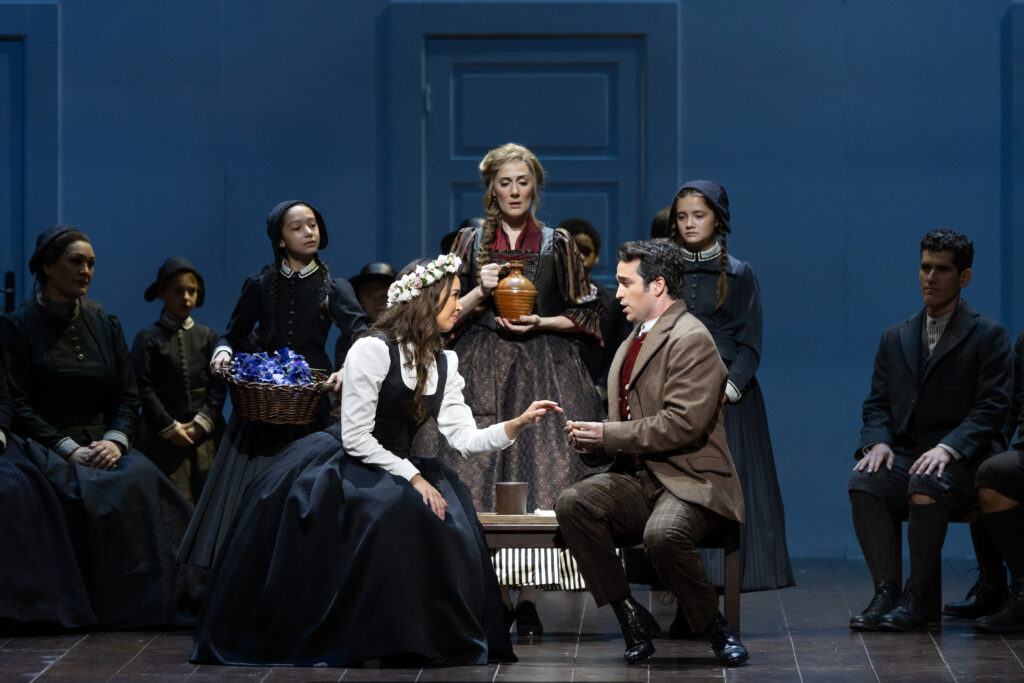
Marty Sohl/ Metropolitan Opera
Not Enough Time
In the role of Lisa, Sydney Mancasola showed promise in her first aria, “Tutto e gioia tutto e festa,” with a solid legato line and a bright top that expressed the character’s sadness. I was hoping that after a solid start, she would be able to shine in her second solo aria, “De’ lieti auguri a voi son grata.” However, the soprano struggled with some of the coloratura lines, and it didn’t help that the cavatina was cut with no repeat, giving Mancasola no time to display her virtuosity. It was a missed opportunity.
Alexander Vinogradov, who sang the role of Rodolfo, also got the short end with his cavatina, “Tu non sai con quei begli occhi,” as he sang it with rich tones and precise rhythms. But the lack of a repeat made the moment less exciting. The bass did sing “Vi ravviso, o luoghi ameni” with elegance and authority. That said, for a bass who has made an impression in Verdi roles, this bel canto role didn’t quite show the many colors he can offer. Vinogradov did shine in the ensemble recitative, “Voi signor signor conte agli occhi,” as he sang with clarity, his bass riding over the chorus.
Deborah Nansteel as Teresa and Nicholas Newton as Alessio slowly warmed up to their parts, but they were much too small to really get a clear picture of their vocal capabilities.
The Stars
Xabier Anduaga returned to the Met for the first time since his debut in 2023. The Spaniard’s demeanor throughout the evening was one of restraint and jealousy, but also playfulness, especially in his duets with Sierra. You could tell that Elvino was attempting to break free from his constraints of this society as well.
Vocally, he had all the goods of a great bel canto singer. His opening “Prendi: l’anel ti dono” was sung with an exquisite tone that flowed with elegance from one line to the next. He could easily build a line from a forte and decrescendo to a piano with ease, and his coloratura lines were accurate. On the repeat, when his voice joined with Sierra’s, Anduaga sang with ardor and some gorgeous pianissimi, especially on the phrase “Il tuo con me restò.” The following “Ah! vorrei trovar parole” was sung with a bright tone and some virtuosic, gleaming high notes that resonated potently in the auditorium. In the duet, “Son geloso del zefiro errante,” as noted, he and Sierra sang with blended tones that had gentleness and made for one of the most memorable moments in the opera. Meanwhile, his anger and pain came through in “D’un pensiero e d’un accento,” which was then emphasized further with accented phrases on “Non piu nozze.” In the “Non è questa, ingrato core” he sang each line with precision. His big scene, “Tutto e sciolto,” saw the tenor’s opening phrase emphasize a tearful Elvino with a pure pianissimo sound. Upon seeing Sierra’s Amina, the anger returned with the tenor singing with a commanding fortissimo and driving the tempo forward, all while interpolating some incredibly impressive high notes. In his cadenza, “Sono, o cruda, e il son per te,” Anduaga used his time and spaced out each line slowly dying down and ending the aria with a heart-felt pianissimo.
The subsequent “Ah! perche non posso odiarte” was well sung with great coloratura and impeccable high notes, but Anduaga did not have time to really develop this piece, as he was unable to repeat the aria. Yes, it was impressive, especially the held-out high note at the end, but it just felt like an afterthought, and it was not helped by the random blackout for a scene change. His moment to shine was therefore cut short.
In the pit, Riccardo Frizza led a swift reading of the score, especially in the stretti of the ensemble pieces and codas of the cavatinas. The tempo for “Non è questa, ingrato core” was energetic and emphasized the chaos in the scene, while the choral numbers were also well-built, especially as Bellini continues adding one voice each time the melody is repeated. You always felt like the melody was moving forward. It was also impressive how Frizza never missed an entrance for his soloists. I only wish that Frizza could come to the Met and do a reading of a critical edition of a score, giving audiences a complete reading as he has been able to do at many of the leading theaters in the world, and allow the Met to rediscover this music the way it was meant to be performed.
In all, this was a disappointing evening, especially for the return of an important bel canto staple.
